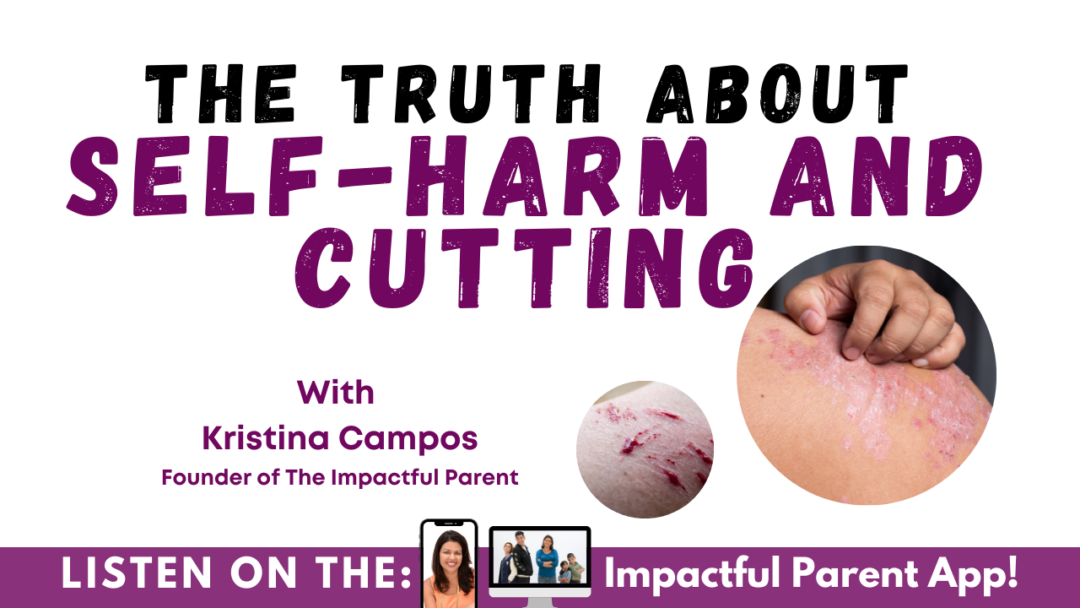The Truth About Self-Harm and Cutting
Kristina Campos, the founder of The Impactful Parent, talks to parents about the warning signs of self-harm, what parents should look for, myth busters about cutters, what parents can do to support their child, and warning signs that the situation is getting worse.
Click on the link below to listen to the podcast! 👇
LINKS MENTIONED IN THE RECORDING
https://theimpactfulparent.com/app Download the FREE Impactful Parent App! Available on Apple and Android App Stores. FREEBIES from episodes included!
Apple Store: https://theimpactfulparent.com/ios
Android Play Store: https://theimpactfulparent.com/android
https://theimpactfulparent.com for more FREE Resources and paid programs.
Rate, Review, & Subscribe!

“I love Kristina and all the FREE tips that she has to offer! Thank you for making my parenting journey better!” <– If that sounds like you, please consider rating and reviewing my show! This helps me support more people — just like you!!!
Rate with five stars, and select “Write a Review.” Then be sure to let me know what you loved most about the episode!
Also, if you haven’t done so already, subscribe to the podcast. I’m adding a bunch of bonus episodes to the feed and, if you’re not subscribed, there’s a good chance you’ll miss out. Subscribe now!
What to do next:
1. Get The Impactful Parent App! Everything you need in your parenting journey in one spot! Available on the Android Play Store and the Apple Store. Search Impactful Parent (direct links listed above under Links in Episode).
2. Follow The Impactful Parent on social media if you don’t already! Facebook, Instagram, LinkedIn, & Pinterest
4. Check out the official website of The Impactful Parent for FREE RESOURCES, parenting classes, mom’s groups, and so much more! Click here to check it out!
5. Discover how you can work with Kristina! Sign up for a FREE 30-minute discovery call! Click here to find a time that works best for you!
Bottom Line… I am here for YOU! Contact me at [email protected]

TRANSCRIPT
The Truth About Self-Harm
“Why are you doing this? Hurting yourself if not the solution.”
That was my first reaction when I was a young teacher teaching high school, and I found blade marks on the legs of one of my students when their shorts rode up a little too high on that unusually hot day. My student was quick to pull their shorts down to cover the marks I had seen. Her face turned red with embarrassment, and then she angrily spoke back, “It’s not your business,” while she stood up and walked out of the classroom.
I didn’t handle that well. I was inexperienced and reacted to what I saw instead of taking the time to think about how best to approach and help my student. I’ve learned a lot since then. I’ve also seen undeniable patterns of self-harm over the years. First, self-harm habits are increasing in our young people. Second, I don’t know why but teenagers’ most difficult months of stress, anxiety, and despair seem to be October and April.
Hello, my name is Kristina Campos. I am the founder of the Impactful Parent. Every week I give you new parenting videos that can help you in your parenting journey. If you have a particular topic or parenting question about your school-aged child that you would like me to address, please submit it at [email protected] or by messaging me on social media. All submissions are kept anonymous.
Today I am going to talk to you about self-harm and cutting. Why do kids do it? What to look for in your child? How can parents help their children? And stick around to the end because I will also be giving you the warning signs that the situation is getting worse. We got a lot to cover, so let’s get started!

The Truth About Self Harm
Self-harm is when a person hurts themselves to deal with difficult feelings, painful memories, overwhelm, and/or trauma. The most common forms of self-harm are cutting, burning, carving words or symbols into the skin, self-hitting, self-punching, head banging, scratching, piercing the skin with sharp objects, headbanging, and inserting objects under the skin. The most popular form of self-harm for girls is cutting. This might look like a child taking a razor blade or other sharp object and passing the blade across the skin, hard enough to penetrate a cut, creating lines, words, symbols, or even too many reports of accidental injury. For boys, their most popular form of self-harm is punching or hitting themselves. In fact, the average age of a child’s first indecent self-harm is around 13 years old. I want parents to know that self-harm can also start earlier than that. Age 13 is only an average. This isn’t just a problem with teenagers. Parents need to be aware of their child’s body without being too invasive on the child. Most self-harm will leave a mark, and most marks are left on the arms, legs, and the front torso. So if you find your child wearing long sleeves on a particularly warm day, long pants at the beach, or a sudden refusal to go to the pool (aka-get into a swimsuit), pause and notice. Those behaviors are warning signs of self-harm. Parents want to look for fresh cuts, scratches, bruises, bite marks, picking at the skin, rug burns (which come from the excessive rubbing of an area to create a burn), and even watch out for your child reporting injury too often, perhaps claiming they are clumsy.
Now I’d like to debunk a few common misconceptions about self-harm that many parents don’t understand.
Myth 1: If the child is self-harming, they want to kill themselves.
Self-harm does NOT have to be an attempt to kill oneself. In fact, most of the time, it is not. Self-harm is a coping mechanism. It is a way to deal with big emotions. Most suicide attempts are well thought out and planned; however, most self-harm is impulsive.
What does this mean for parents? Your child is suffering emotionally. They are not in a good place mentally and need help. Whatever they are dealing with has them hurting so badly that they look to hurting themselves externally to feel better.

The Truth About Self Harm
Myth 2: The child is self-harming to seek attention.
Your child might be giving a cry for help when they show their wounds to someone, but most self-harm is hidden. Children hide the evidence of harming themselves because they feel embarrassed and scared to get in trouble. A lot of kids are ashamed of the marks left behind from self-harm.
What does this mean for parents? Your child needs help learning coping skills, not a lecture about how awful it is they are hurting themselves. They already know it’s bad. Your child doesn’t have good coping tools to help with psychological pain. They can’t manage their emotions productively. Your child is having trouble regulating, expressing, and understanding all the big feelings. They likely feel worthless, lonely, mad, rejected, and even guilty. They need help. Taking them to a therapist, they feel comfortable talking to will be an important next step. The therapist might ask a psychiatrist to prescribe anti-depressive medication also, depending on your situation.
Myth 3: This is a phase.
No, this is not a phase. Self-harm needs to be taken seriously, so it doesn’t spiral into bigger problems. “A phase” implies that kids just go through this in development, which is normal. Self-harm is not normal. Kids with an increased risk of self-harm might have friends who are doing it. They might be using drug/alcohol, have gone through mental trauma, or have other underlying mental health issues.
What does this mean to parents? Keep vigilant and look out for self-harm. Why people self-harm is unique to every person. It is literally different for everyone. The child is often trying to punish themselves, turn emotional pain into physical pain, and/or stop feeling numb. These children need your help. Watch your child closely, don’t judge them for their actions; instead, show your child your concern and love. Get your child to a therapist as soon as possible to start learning more productive coping strategies. Lastly, there are support groups out there for both parents and children. Finding a safe space to vent around people who understand you can be one of the most powerful tools for overcoming this difficult time.
Lastly, what are the warning signs of the situation getting worse? Let’s just say it. How do I know the difference between my child self-harming to cope or self-harming to commit suicide?

The Truth About Self Harm
I know you’re scared. Be mindful of your child’s space and privacy, but watch them closely. Here are the things you want to look for that things might be getting worse.
- Neglecting their appearance
- Giving away items
- Extreme mood swings
- Talking about wanting to die or kill themselves
- Writing about death
- Withdrawing from everyone. Isolating themselves
- Talking about feeling trapped
- Behaving recklessly
- Show extreme anger and talk about seeking revenge
- Sleeping too little. Sleeping too much.
- Increased use of alcohol and/or drugs
- Talking about being a burden on others
- Looking online for ways to die
- Sudden calmness and making preparations
If these warning signs resonate with your family, please take your child to the local hospital emergency room for evaluation and start the process of seeking help.
If you have a topic or a parenting question about your school-aged child, please ask! Submit your questions by social media DM or email me at [email protected]. Plus, if you want to become a more Impactful Parent, check out all my website offers! I have parenting courses, family coaching, a free downloadable app, and many free resources. But until next time, you got this, parents. I am just here to help.
It takes a lot to run a family! Here are a few products I recommend.
Gabb Wireless: The BEST first phone for your child!
- No internet, no social media, and NO WORRIES! This phone has GPS tracking and other features that parents want to have peace of mind about their child having a phone. The Gabb Wireless phone has the sleek look of a smartphone that kids love without worry and high price. To find out more and order your phone (or watch) go to: gabbwireless.com/promo/IMPACTFULPARENT30

